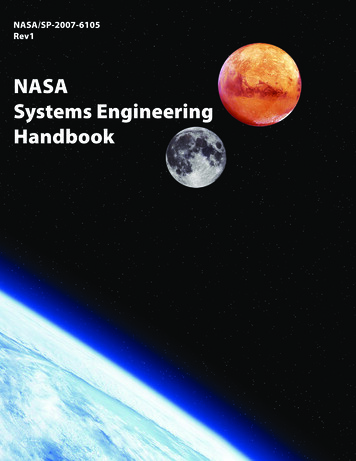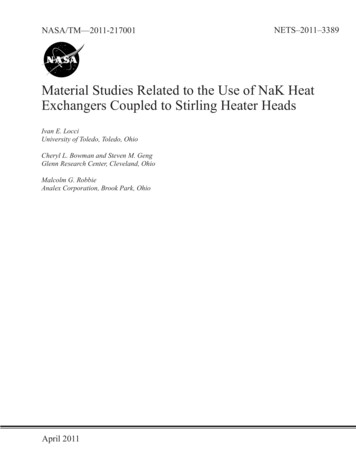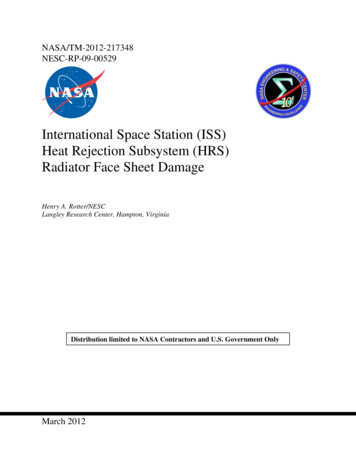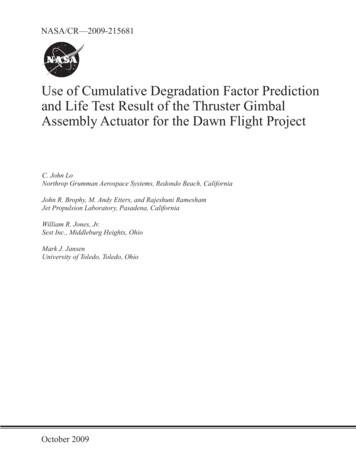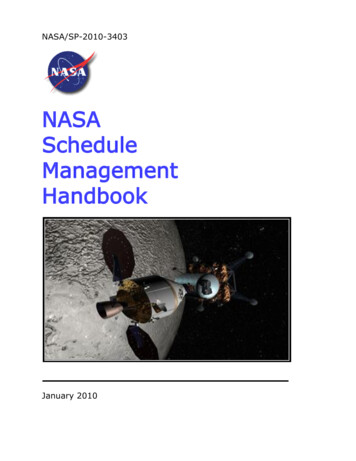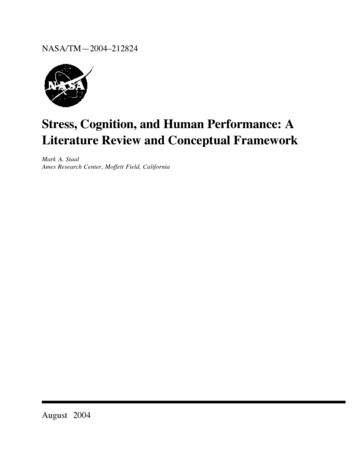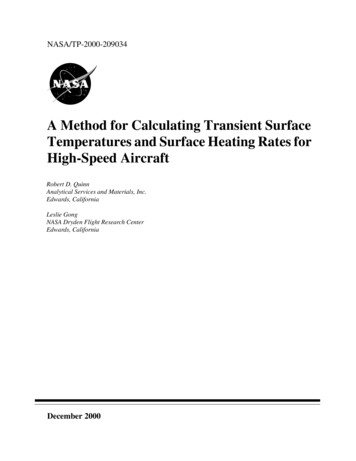
Transcription
National Aeronautics and SpaceAdministration Goddard Earth Science DataInformation and Services Center (GES DISC)README Document forNASA GLDAS Version 2 Data ProductsLast Revised August 6, 2019Goddard Earth Sciences Data and Information Services Center (GES DISC)http://disc.gsfc.nasa.govNASA Goddard Space Flight CenterCode 610.2Greenbelt, MD 20771 USA
README for NASA GLDAS Version 2 DataProductsPrepared By:Hualan RuiHiroko BeaudoingGES DISCGSFC Code 610.2Hydrological Sciences Laboratory (HSL)GSFC Code 617August 6, 2019DateReviewed By:Carlee LoeserAugust 6, 2019GES DISCGSFC Code 610.2DateGoddard Space Flight CenterGreenbelt, Maryland2
README for NASA GLDAS Version 2 DataProductsRevision HistoryRevision DateChanges05/19/2010Initial version based on information from HirokoBeaudoing.06/17/2010Review and revise11/21/2011Update GES DISC Helpdesk email address10/16/2012Add information for GLDAS-2.011/01/2012Add information for GLDAS-2.011/15/2013Add information for GLDAS-2.0 0.25o product11/18/2014Update Table 3 for additional fields05/12/2015Add Table 2: DOIs for GLDAS-2 products06/16/2015Add information for GLDAS-2.0 products07/03/2015Review and revise07/22/2016Add information for GLDAS-2.1 Noah 1.0 o products08/01/2016Add GLDAS-1 and GLDAS-2.1 differences11/11/2016Add information for GLDAS-2.1 Noah 0.25 o products02/08/2017Convert to comply with the newer README template07/18/2017Update URLs to comply with GES DISC new Web site11/16/2017Add more information regarding accumulation variables12/20/2017Add information for Catchment model data02/02/2018Add data interpretation for TWS02/06/2018Review and revise03/29/2018Add DOI for Catchment model data product04/05/2019Update Data Interpolation for TWS and GWS08/06/2019Update References and add snow density note3AuthorHualan RuiHiroko BeaudoingHualan RuiHiroko BeaudoingHualan RuiHiroko BeaudoingHualan RuiHualan RuiHualan RuiHiroko BeaudoingHiroko BeaudoingHiroko BeaudoingHualan RuiHualan RuiHualan RuiCarlee LoeserHiroko BeaudoingHiroko BeaudoingBailing LiHualan RuiHualan RuiCarlee Loeser
README for NASA GLDAS Version 2 DataProductsTable of Contents1.0 Introduction .51.1 Dataset Basic characteristics .51.2 Digital Object Identifier (DOI) and Citation .61.3 Contact Information .71.4 What’s New? .81.4.1 What are the differences between GLDAS-1 and GLDAS-2? .81.4.2 What is new about the reprocessed GLDAS-2.0? .91.4.3 What are the differences between GLDAS-1 and GLDAS-2.1? .92.0 Data Organization . 102.1 File Naming Convention . 102.2 File Format and Structure . 103.0 Data Contents . 113.1 Noah Model Data . 113.2 Catchment Model Data. 123.3 Data Interpretation. 134.0 Options for Reading the Data . 154.1 Utilities . 154.2 Panoply . 154.3 GrADS . 155.0 Data Services . 185.1 NASA Earthdata Login System. 185.2 Data services . 195.2.1 HTTP . 195.2.2 EarthData Search . 195.2.3 OPeNDAP . 195.2.4 GrADS Data Server (GDS) . 195.2.5 Giovanni . 196.0 More Information . 207.0 Acknowledgements . 20References . 21Acronyms . 224
README for NASA GLDAS Version 2 DataProducts1.0 IntroductionThis document provides basic information for using NASA GLDAS Version 2 products.The goal of the NASA Global Land Data Assimilation System (GLDAS) is to ingest satellite- andground- based observational data products, using advanced land surface modeling and dataassimilation techniques, in order to generate optimal fields of land surface states and fluxes(Rodell et al., 2004). GLDAS drives multiple, offline (not coupled to the atmosphere) land surfacemodels, integrates a huge quantity of observation based data, and executes globally at highresolutions (2.5 to 1 km), enabled by the Land Information System (LIS) (Kumar et al., 2006).Currently, GLDAS drives four land surface models (LSMs): Noah, Catchment, the Community LandModel (CLM), and the Variable Infiltration Capacity (VIC). More information is available at theLand Data Assimilation Systems (LDAS) and Land Information System (LIS) websites.This document specifically describes the data products of Version 2 of the Global Land DataAssimilation System (hereafter, GLDAS-2).1.1 Dataset Basic characteristicsNASA GLDAS-2 has two components: one forced entirely with the Princeton meteorologicalforcing data (hereafter, GLDAS-2.0), and the other forced with a combination of model andobservation based forcing datasets (hereafter, GLDAS-2.1). GLDAS-2.0 currently extends from1948 through 2014 and will be extended to recent years as the dataset becomes available. GLDAS2.1 extends from 2000 to present with about 1.5 month latency and will be updated monthly.Other LSMs simulation outputs will be added to GLDAS-2.1 as they become available. GLDAS-2.1is a replacement for GLDAS-1 product stream. Daily Catchment LSM outputs at 0.25-degreeresolution are added to the GLDAS-2.0 suite (Li et al, 2017), and reprocessing of GLDAS-2.0 withthe latest Princeton meteorological dataset, version 2.2 through 2014 is undergoing for the NoahLSM as of late 2017.The temporal resolution for the GLDAS-2 products are 3-hourly and daily. The monthly productsare generated through temporal averaging of the 3-hourly products. Table 1 lists some basiccharacteristics of the GLDAS-2 data. Please check up on the newest hydrology data related alertmessage at GES DISC Alerts.Table 1. Basic characteristics of the NASA GLDAS-2 data.ContentsOutputs from NOAH and Catchment Land surface modelsFormatNetCDFLatitude extent-60 to 90 Longitude extent-180 to 180 Spatial resolution1.0 , 0.25 Temporal resolution 3-hourly, daily, and monthly5
README for NASA GLDAS Version 2 DataProductsTemporal coverageGLDAS-2.0: 03Z Jan 1, 1948 – 21Z Dec 31, 2014GLDAS-2.1: 03Z Jan 1, 2000 – present, with 1.5 month latency360 (lon) x 150 (lat) for the 1.0 x 1.0 data productsDimension1440 (lon) x 600 (lat) for the 0.25 x 0.25 data productsOrigin (1st grid center) (179.5W, 59.5S) for the 1.0 x 1.0 data products(179.875W, 59.875S) for the 0.25 x 0.25 data productsLand Surface Models NOAH 3.3, Catchment-F2.5The GLDAS-2.0 model simulations were initialized on simulation date January 1, 1948, using soilmoisture and other state fields from the LSM climatology for that day of the year. The simulationswere forced by the global meteorological forcing data set from Princeton University (Sheffieldet al., 2006). Each simulation uses the common GLDAS data sets for land water mask (MOD44W:Carroll et al., 2009) and elevation (GTOPO30) along with the model default land cover and soilsdatasets. Noah model uses the Modified IGBP MODIS 20-category vegetation classification andthe soil texture based on the Hybrid STATSGO/FAO) datasets. Catchment model uses theMosaic land cover classification and soils, topographic, and other model-specific parameterswere derived in a consistent manner as in the NASA/GMAO’s GEOS-5 climate modeling system.The MODIS based land surface parameters are used in the current GLDAS-2.0 and GLDAS-2.1products while the AVHRR base parameters were used in GLDAS-1 and previous GLDAS-2products (prior to October 2012).The GLDAS-2.1 simulation started on January 1, 2000 using the conditions from the GLDAS-2.0simulation. This simulation was forced with National Oceanic and Atmospheric Administration(NOAA)/Global Data Assimilation System (GDAS) atmospheric analysis fields (Derber et al.,1991), the disaggregated Global Precipitation Climatology Project (GPCP) precipitation fields(Adler et al., 2003), and the Air Force Weather Agency’s AGRicultural METeorological modelingsystem (AGRMET) radiation fields which became available for March 1, 2001 onwards.1.2 Digital Object Identifier (DOI) and CitationUsers of GLDAS data products should cite, in research papers, the data used, along with theirDigital Object Identifiers (DOIs) (Table 2). A DOI is a unique alphanumeric string used to identifya digital object and provide a permanent link online. DOIs are often used in online publicationsin citations.Table 2. DOIs for NASA GLDAS-2 Data ProductsProduct Short NameProduct DescriptionGLDAS Noah Land Surface Model L4GLDAS NOAH025 3H 2.0 3 hourly 0.25 x 0.25 degree, V2.0GLDAS NOAH025 M 2.0GLDAS Noah Land Surface Model L4monthly 0.25 x 0.25 degree, V2.06DOI10.5067/342OHQM9AK6Q10.5067/9SQ1B3ZXP2C5
README for NASA GLDAS Version 2 DataProductsGLDAS Noah Land Surface Model L43 hourly 1.0 x 1.0 degree, V2.0GLDAS Noah Land Surface Model L4GLDAS NOAH10 M 2.0monthly 1.0 x 1.0 degree, V2.0GLDAS Noah Land Surface Model L4GLDAS NOAH025 3H 2.1 3 hourly 0.25 x 0.25 degree, V2.1GLDAS Noah Land Surface Model L4GLDAS NOAH025 M 2.1 monthly 0.25 x 0.25 degree,VersionGLDAS Noah Land Surface Model L4GLDAS NOAH10 3H 2.1 3 hourly 1.0 x 1.0 degree, V2.1GLDAS Noah Land Surface Model L4GLDAS NOAH10 M 2.1monthly 1.0 x 1.0 degree, V2.1GLDAS Catchment Land SurfaceGLDAS CLSM025 D 2.0Model L4 daily 0.25 x 0.25 degree,V2.0GLDAS NOAH10 3H DA910.5067/LWTYSMP3VM5Z10.5067/LYHA9088MFWQEach of DOIs in Table 2 is linked to its corresponding data product page. On the page, the tab“Data Citation” provides the recommended citation for that product. If you use a GLDAS dataproduct(s) in your research or applications, please include the corresponding reference(s) inyour publication(s). The following is an example citation (for GLDAS NOAH025 3H 2.1):Beaudoing, Hiroko and M. Rodell, NASA/GSFC/HSL (2016), GLDAS Noah Land Surface Model L43 hourly 0.25 x 0.25 degree V2.1, Greenbelt, Maryland, USA, Goddard Earth Sciences Data andInformation Services Center (GES DISC), Accessed [Data Access Date] 10.5067/E7TYRXPJKWOQPrimary Reference:Rodell, M., P. R. Houser, U. Jambor, J. Gottschalck, K. Mitchell, C.-J. Meng, K. Arsenault, A.Cosgrove, J. Radakovich, M. Bosilovich, J. K. Entin, J. P. Walker, D. Lohmann, and D. Toll, 2004.The Global Land Data Assimilation System, Bull. Amer. Meteor. Soc., 85(3): 381-394.1.3 Contact InformationFor information about or assistance in using any GES DISC data, please contact the GES DISCHelp Desk at:GES DISCCode 610.2NASA Goddard Space Flight CenterGreenbelt, Maryland 20771Email: gsfc-helpdisc@lists.nasa.gov 301-614-5224(voice)301-614-5268 (fax)For general science questions and comments, please contact:7
README for NASA GLDAS Version 2 DataProductsMatthew Rodell, Ph.D.Hydrological Sciences Laboratory, Code 617NASA Goddard Space Flight CenterGreenbelt, MD 20771Email: Matthew.Rodell@nasa.govPhone: 301-286-9143OrHiroko Kato Beaudoing, M.S.Earth System Science Interdisciplinary CenterUniversity of Maryland, College ParkHydrological Sciences Laboratory, Code 617NASA Goddard Space Flight Center Greenbelt,MD 20771Email: Hiroko.Kato-1@nasa.gov Phone:301-286-9143OrBailing Li, Ph.D.Earth System Science Interdisciplinary CenterUniversity of Maryland, College ParkHydrological Sciences Laboratory, Code 617NASA Goddard Space Flight Center Greenbelt,MD 20771Email: bailing.li-1@nasa.gov1.4 What’s New?1.4.1 What are the differences between GLDAS-1 and GLDAS-2?GLDAS-1 forcing data sources were switched several times, over the record from 1979 to present,which introduced unnatural trends and resulted in highly uncertain forcing fields in ASforcing.php.GLDAS-2 has two components, GLDAS-2.0 and GLDAS-2.1. The main objective for GLDAS-2.0 is tocreate more climatologically consistent data sets, using the “Global Meteorological ForcingDataset” from Princeton University, currently extending from 1948 - 2010. GLDAS-2.1 isanalogous to GLDAS-1 product stream, with upgraded models forced by a combination of GDAS,disaggregated GPCP, and AGRMET radiation data sets.Other enhancements made in GLDAS-2 include model version upgrade, switching to MODISbased land surface parameter data sets, and initialization of soil moisture over desert. In the Noahmodel, the bottom layer temperature was also updated. More details regarding the land surfaceparameter data changes are available at https://ldas.gsfc.nasa.gov/gldas/.8
README for NASA GLDAS Version 2 DataProducts1.4.2 What is new about the reprocessed GLDAS-2.0?The GLDAS-2.0 data have been reprocessed with updated Princeton Forcing V2.2 Data andupgraded Land Information System (LIS) software. The reprocessed GLDAS-2.0 data are archivedin NetCDF-4 format. Additional model output fields are included (see Table 3). Streamlining theoutput format resulted in changing some of the units from the GLDAS2.0 data prior to July 2015.The land surface characteristics (i.e. land cover, soil texture) over some grid cells were modifieddue to a bug fix. Details of the changes and the new land surface parameter datasets are availableat https://ldas.gsfc.nasa.gov/gldas/.1.4.3 What are the differences between GLDAS-1 and GLDAS-2.1?The main objective of GLDAS-2.1 is to provide up-to-date global land surface model outputs, usingobservation based forcing, while preserving consistency of the long term climatology (i.e. GLDAS2.0) to the extent possible. Two major issues were found in the GLDAS-1 forcing fields. First, theAGRMET shortwave downward flux displayed sharp, unnatural gradient lines in the NorthernHemisphere in certain years. Second, there was a dramatic change in precipitation in certainlocations starting in 2009. Furthermore, comparisons of GLDAS-1 radiation and precipitationfields revealed that GLDAS-1 had high bias relative to the well-validated Surface Radiation Budget(SRB) dataset (Stackhouse et al., 2011) and GLDAS-1 precipitation (i.e. CMAP) had low bias relativeto the Global Precipitation Climatology Project (GPCP) dataset. Similar biases were observedcompared to GLDAS-2.0 (i.e. Princeton forcing) whose radiation fields were bias corrected to theSRB dataset and precipitation fields were disaggregated using the GPCP and Tropical RainfallMeasuring Mission (TRMM) datasets.GLDAS-2.1 addressed these issues as follows. The AGRMET radiation flux fields are bias correctedusing the period of overlap between AGRMET and SRB (2002-2007) to compute monthly, griddedscale factors that are applied for the overlapping period of AGRMET data. Similarly, GDASradiation fields were bias corrected to SRB for the period of 2000-2001/02. Because AGRMETdisplayed high bias compared to SRB, the fluxes for 2008 onwards are adjusted by applyinganother set of gridded scale factors that are computed from annual mean climatology of 20022007, thus avoiding a discontinuity in the GLDAS-2.1 data. The bias-corrected AGRMET forcingdata should be consistent with the climatology of SRB, however, due to the short overlappingperiod, the scaling approach is unable to correct an apparent shift (of unknown origin) in theAGRMET climatology after 2011. For the precipitation fields, we use the GPCP 1-degre Daily (1DD)v1.2 dataset (Huffman et al., 2001) and an updated disaggregation routine (making use of GDASprecipitation fields) to prepare 3-hourly GPCP fields. However, the GPCP 1DD data is not updatedregularly and currently ends in October, 2015. Consequently, at the time of writing the GDAS wasused for November, 2015 onwards in order to run GLDAS-2.1 up to present. Once the GPCP datais updated, GLDAS-2.1 will be reprocessed for the recent months.9
README for NASA GLDAS Version 2 DataProducts2.0 Data OrganizationThe GLDAS-2.0 and GLDAS-2.1 consist of 3-hourly, daily, and monthly data products at 0.25 x 0.25 and 1.0 x 1.0 resolutions.2.1 File Naming ConventionNASA GLDAS-2 data are named in accordance with the following convention:GLDAS Model Grid spacing Temporal spacing A Date . Product version .nc4AttributeDescription Model “NOAH” for the Noah Model“CLSM” for the Catchment Model“CLM” for the Common Land Model“VIC” for the Variable Infiltration Capacity Model Grid spacing “025” for 1/4th degree“10” for 1.0 degree“3H” for 3-hourly datasets“D” for daily datasets“M” for monthly datasets YYYYMMDD . HHHH for 3-hourly Temporal spacing Date * YYYYMMDD for daily datasets YYYYMM for monthly datasets“020” for GLDAS-2.0“021” for GLDAS-2.1* (4-digit year; 2-digit month; 2-digit day of month; 4-digit GMT hour of day) Product version For examples, file name for monthly 1.0 degree GLDAS-2.0 Noah data for January 1948 is“GLDAS NOAH10 M A194801.020.nc4” and file name for 3-hourly 0.25 degree GLDAS-2.1Noah data at 03:00Z on 1 January 2000 is “GLDAS NOAH025 3H.A20000101.0300.021.nc4.”File name for daily 0.25 degree GLDAS-2.0 Catchment data on 1 January, 1948 is“GLDAS CLSM025 D.A19480101.0000.020.nc4”.2.2 File Format and StructureThe GLDAS-2 data files are in NetCDF format, which is a set of software libraries and selfdescribing, machine-independent data formats that support the creation, access, and sharing ofarray-oriented scientific data, .10
README for NASA GLDAS Version 2 DataProducts3.0 Data Contents3.1 Noah Model DataBoth 3-hourly and monthly data products from GLDAS-2 Noah model contain thirty-sixparameters, as listed in Table 3.1. Brief description about Noah Model is available h.Table 3.1 Parameters in the GLDAS-2 Noah model dataShort NameSwnet tavgLwnet tavgQle tavgQh tavgQg tavgSnowf tavgRainf tavgEvap tavgQs accQsb accQsm accAvgSurfT instAlbedo instSWE instSnowDepth instSoilMoi0 10cm instSoilMoi10 40cm instSoilMoi40 100cm instSoilMoi100 200cm instSoilTMP0 10cm instSoilTMP10 40cm instSoilTMP40 100cm instSoilTMP100 200cm instPotEvap tavgECanop tavgTveg tavgESoil tavgRootMoist instCanopInt instWind f instDescriptionNet short wave radiation fluxNet long-wave radiation fluxLatent heat net fluxSensible heat net fluxHeat fluxSnow precipitation rateRain precipitation rateEvapotranspirationStorm surface runoffBaseflow-groundwater runoffSnow meltAverage Surface Skin temperatureAlbedoSnow depth water equivalentSnow depthSoil moistureSoil moistureSoil moistureSoil moistureSoil temperatureSoil temperatureSoil temperatureSoil temperaturePotential evaporation rateCanopy water evaporationTranspirationDirect Evaporation from Bare SoilRoot zone soil moisturePlant canopy surface waterWind speed11UnitW m-2W m-2W m-2W m-2W m-2kg m-2 s-1kg m-2 s-1kg m-2 s-1kg m-2 per 3-hourkg m-2 per 3-hourkg m-2 per 3-hourK%kg m-2Mkg m-2kg m-2kg m-2kg m-2KKKKW m-2W m-2W m-2W m-2kg m-2kg m-2m/s
README for NASA GLDAS Version 2 DataProductsRainf f tavgTotal precipitation ratekg m-2 s-1Tair f instTemperatureKQair f instSpecific humiditykg/kgPsurf f instPressurePaSWdown f tavgDownward short-wave radiation W m-2LWdown f tavgDownward long-wave radiation W m-2The short names with extension “ tavg” are past 3-hr averaged variables. Theshort names with extension “ acc” are past 3-hr accumulated variables. Theshort names with extension “ inst” are instantaneous variables.The short names with “ f” are forcing variables.3.2 Catchment Model DataDaily product from GLDAS-2 Catchment model contains thirty-three parameters, as listed inTable 3.2. Brief description about Catchment Model is available M.Table 3.2 Parameters in the GLDAS-2 Catchment model dataShort NameSwnet tavgLwnet tavgQle tavgQh tavgQg tavgSnowf tavgRainf tavgEvap tavgQs tavgQsb tavgQsm tavgSnowT tavgAvgSurfT tavgSWE tavgSnowDepth tavgSoilMoist S tavgSoilMoist RZ tavgSoilMoist P tavgECanop tavgTveg tavgESoil tavgCanopInt tavgDescriptionNet short wave radiation fluxNet long-wave radiation fluxLatent heat net fluxSensible heat net fluxHeat fluxSnow precipitation rateRain precipitation rateEvapotranspirationStorm surface runoffBaseflow-groundwater runoffSnow meltSnow Surface temperatureAverage Surface Skin temperatureSnow depth water equivalentSnow depthSurface Soil moistureRoot Zone Soil moistureProfile Soil moistureCanopy water evaporationTranspirationDirect Evaporation from Bare SoilPlant canopy surface water12UnitW m-2W m-2W m-2W m-2W m-2kg m-2 s-1kg m-2 s-1kg m-2 s-1kg m-2 s-1kg m-2 s-1kg m-2 s-1KKkg m-2Mkg m-2kg m-2kg m-2kg m-2 s-1kg m-2 s-1kg m-2 s-1kg m-2
README for NASA GLDAS Version 2 DataProductsEvapSnow tavgAcond tavgTWS tavgGWS tavgWind f tavgRainf f tavgTair f tavgQair f tavgPsurf f tavgSWdown f tavgLWdown f tavgSnow EvaporationAerodynamic conductanceTerrestrial Water StorageGround Water StorageWind speedTotal precipitation rateTemperatureSpecific humidityPressureDownward short-wave radiationDownward long-wave radiationkg m-2 s-1m s-1mmmmm s-1kg m-2 s-1Kkg/kgPaW m-2W m-2The short names with extension “ tavg” are 24-hr averaged variables.The short names with “ f” are forcing variables.3.3 Data Interpretation1. Due to unreliable Greenland forcing data and the lack of a glacier/ice sheet model, snowwater equivalent accumulates indefinitely in Greenland and a few other Arctic points.Therefore it is highly recommended that Greenland and other points with abnormallylarge snow water equivalent values be masked out when performing global analyses.2. Total precipitation rate is the sum of rain and snow precipitation rates. The forcing variable“Rainf f tavg” is the total precipitation rate whereas “Rainf tavg” and “Snowf tavg” are theliquid precipitation rate and frozen precipitation rate, respectively.3. Total runoff is the sum of subsurface runoff and surface runoff.4. The Catchment land surface model (CLSM) does simulate shallow groundwater, soTerrestrial Water Storage (TWS) in CLSM is the sum of soil water, snow water equivalent,canopy water, and groundwater. Ground Water Storage (GWS) in CLSM is alreadyincluded in TWS. Ground Water Storage (GWS) in CLSM was computed using formula:GWS TWS - Rootzone SoilMoisture - Snow Water Equivalent - Canopy interception.For computing Noah TWS, it is the sum of soil moisture in all layers, accumulated snow,and plant canopy surface water.5. Use temporal averaging, not accumulation, to upscale the data to different temporalresolutions. For example, rainfall and snowfall are provided as rates, i.e., kg/m2/s. So thecorrect method of upscaling is averaging, which does not change the units.6. Monthly average files contain straight averages of 3-hourly data, so that each monthlyaverage has units PER 3 HOURS. For example, total evapotranspiration (Evap tavg) for April1979 is the average 3-hour mean rate of evapotranspiration over all 3-hour intervals inApril 1979. It is NOT the accumulated evapotranspiration in April 1979. To compute thelatter, use this formula:Evap tavg (April){kg/m 2} Evap tavg (April){kg/m 2/sec} * 10800{sec/3hr} * 8{3hr/day} * 30{days}13
README for NASA GLDAS Version 2 DataProductsFor accumulated variables such as Qs acc, monthly mean surface runoff is the average 3-houraccumulation over all 3-hour intervals in April 1979. To compute monthly accumulation, usethis formula:Qs acc (April){kg/m 2} Qs acc (April){kg/m 2/3hr} * 8{3hr/day} * 30{days}7.8.9.10.This would be irrelevant, and the above formulas should not be used, if the field of interestwere an instantaneous state.Heights of forcing fields depend on the data sets used to drive the simulation. Presently,all the GLDAS data sets use the 2 m temperature and specific humidity and the 10 m windfor the entire time span.The number of vertical levels for Soil Temperature and Soil Moisture is model specific.NOAH has total of 4 layers thickness: 0-10, 10-40, 40- 100, and 100-200 cm.CLSM does not have explicit vertical levels, instead soil moisture is represented in Surface (02cm), Root Zone (0-100cm), and Profile (varies grid-by-grid) reservoirs. They are inclusive-Profile includes Surface and Root Zone and Root Zone includes Surface.The mean fields in monthly data (e.g. evapotranspiration, see Table 3) contain straightaverage over 3z on the 1st day of month to 0z on the 1st day of next month. Similarly, theaccumulated fields (e.g. runoff) contain straight average of 3 -hour accumulation from 3zon the 1st to 0z on the first day of next month. The instantaneous fields are averaged over0z on the 1st day of month to 21z on the last day of month.Snow density computed using the snow water equivalent and snow depth included in thecurrent GLDAS CLSM product is not valid. Snow depth was not accounted for the gridfraction of snow cover at the time the simulation was done. Reprocessing the simulationis under consideration.14
README for NASA GLDAS Version 2 DataProducts4.0 Options for Reading the Data4.1 UtilitiesNASA GLDAS-2 data are archived in self-describing and machine-independent NetCDF f/software.html, a Unidata page, provides a list ofsoftware for manipulating or displaying NetCDF Data.4.2 PanoplyPanoply, https://www.giss.nasa.gov/tools/panoply/, is a cross-platform application that plotsgeo-referenced and other arrays from NetCDF, HDF, GRIB, and other data sets.The HowTo of NASA GES DISC provides a recipe for How to View Remote Data in OPeNDAP withPanoply.4.3 GrADSThe Grid Analysis and Display System (GrADS) is an interactive desktop tool for easy access,manipulation, and visualization of earth science data. GrADS supports several data formats, suchas binary, NetCDF, HDF, and GRIB. The documentation and software for GrADS can be found at:http://cola.gmu.edu/grads/grads.php.Each individual GLDAS-2 NetCDF file can be opened by the GrADS utility sdfopen directlywithout a data descriptor file (i.e., a ctl file). After calling sdfopen, GrADS commands, such as “qfile”, “d [variable name]”, etc. can be used to query file information, read and display the data.Below is an example showing how to use sdfopen to read a GLDAS-2 NetCDF file and query forits dimensions and variables.ga- xdfopen GLDAS NOAH10 M.2.0.xdfScanning Descriptor File: GLDAS NOAH10 M.2.0.xdfSDF file/ftp/data/s4pa/GLDAS/GLDAS NOAH10 M.2.0/%y4/GLDAS NOAH10 M.A%y4%m2.020.nc4is open as file 1LON set to 0 360LAT set to -59.5 89.5LEV set to 0 0Time values set: 1948:1:1:0 1948:1:1:0E set to 1 1ga- q fileFile 1 : GLDAS2.0 LIS land surface model output monthly meanDescriptor: GLDAS NOAH10 M.2.0.XDF15
README for NASA GLDAS Version 2 DataProductsBinary: GLDAS NOAH10 M.2.0/%y4/GLDAS NO
Aug 06, 2019 · University of Maryland, College Park Hydrological Sciences Laboratory, Code 617 NASA Goddard Space Flight Center Greenbelt, MD 20771 Email: Hiroko.Kato-1@nasa.gov Phone: 301-286-9143 Or Bailing Li, Ph.D. Earth System Science Interdisciplinary Center University of Maryland, College




